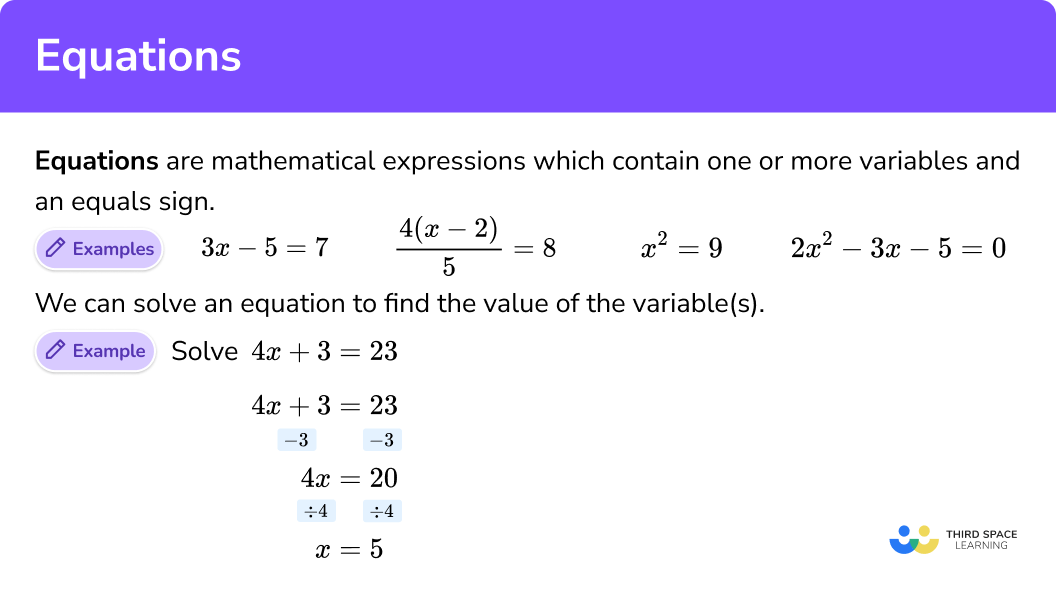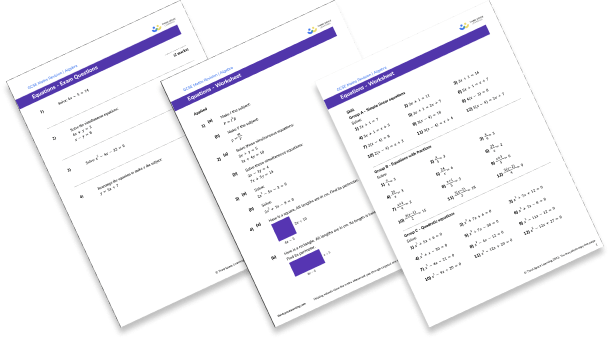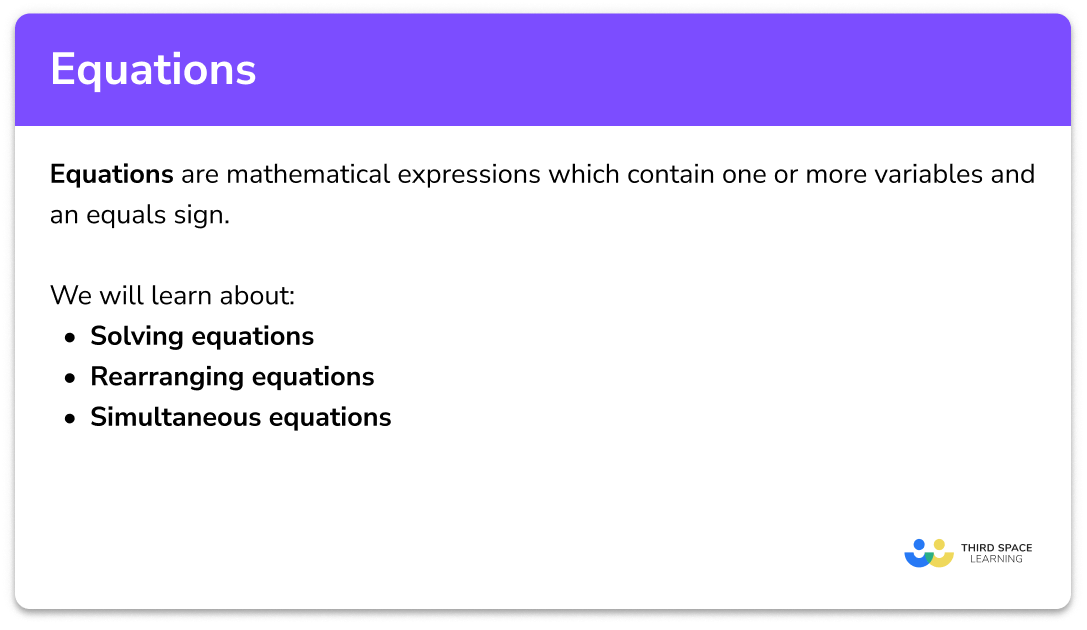One to one maths interventions built for KS4 success
Weekly online one to one GCSE maths revision lessons now available
In order to access this I need to be confident with:
Algebraic notation Simplify algebraic expressions SubstitutionPolynomials
This topic is relevant for:

Equations
Here we will learn about equations, including solving equations, linear equations, quadratic equations, simultaneous equations and rearranging equations.
There are also equations worksheets based on Edexcel, AQA and OCR exam questions, along with further guidance on where to go next if you’re still stuck.
What are equations?
Equations are mathematical expressions which contain a variable and an equals sign.
We can solve different types of equations to find the value of the variable.
E.g.
\begin{aligned} &3x-5=7 \\\\\\ &\frac{4(x-2)}{5}=8 \\\\\\ &x^2=9 \\\\\\ &2x^2-3x-5=0 \end{aligned}What are equations?

What are simultaneous equations?
Simultaneous equations are a pair of equations with two variables. They can be solved to find a pair of values which make both equations true at the same time.
Step-by-step guide: Simultaneous equations
E.g. Linear simultaneous equations
\begin{aligned} x+y&=10\\\\ x-y&=4 \end{aligned}E.g. Quadratic simultaneous equations
y=x^2-6x+8 y=2x+1What is rearranging equations?
Rearranging equations means we change the subject of the equation to display it in a different way.
Step-by-step guide: Rearranging equations
E.g.
The subject of the following equation is currently y .
y=3x+2We can rearrange the mathematical equation to make x the subject:
x=\frac{y-2}{3}Sometimes an equation is a formula. This is when it is used to solve a specific problem.
E.g.
Here is the formula to work out the area of a circle:
A=\pi r^2It could be rearranged to find the radius if we are given the area:
r=\sqrt{\frac{A}{\pi }}
Equations worksheet

Get your free equations worksheet of 20+ questions and answers. Includes reasoning and applied questions.
DOWNLOAD FREE
Equations worksheet

Get your free equations worksheet of 20+ questions and answers. Includes reasoning and applied questions.
DOWNLOAD FREEEquations and identities
Equations and identities look very similar, but are two different things.
An identity is true for all values of the variable, whereas the equation is true for only certain values.
For example, the equation:
3x+5=14can be solved, so it is true only when x=3.
However the identity:
3(x+2)\equiv3x+6It can not be solved. The left-hand side always equals the right-hand side for all values of x.
At A-level you will be introduced to a variety of trigonometric identities to enable you to prove trigonometric expressions such as each pythagorean identity (derived from the pythagoras theorem) or the double angle identities.
Identity sign
Algebraic identities use the ‘≡’ symbol. It is like an equals sign =, but it means ‘identical to’.
Iteration
Iteration is a process in which the approximate solution is determined using an iterative formula and a known starting number. When using iteration to calculate a root of an equation, the values converge towards a fixed point.
Step-by-step guide: Iteration
Solving equations
Types of equations

Linear equations
Simple linear equations are solved by using a “balancing method” by applying the inverse operation to both sides of the equation such as addition, subtraction, multiplication, division or using powers and square roots. They can be checked by substituting the answer back into the original equation.
Step-by-step guide: Linear equations
Linear equations – one unknown
E.g.
Solve: 3x+4=16
Linear equations – unknowns on both sides
E.g.
Solve: 4x+7=2x+12
Linear equations – with brackets
E.g.
Solve: 3(x-5)=18
OR
Equations with fractions
E.g.
Solve: \frac{5}{x}=10
In order to solve the equation you need to multiply both sides by the denominator.
Simple equations – with powers and roots
Whilst these are NOT linear equations they are included here as the method used to solve them is very similar.
E.g.
Solve: 4x^2+1=35
Step-by-step guide: Equations with fractions
Quadratic equations
Quadratic equations are solved by using different methods. They can be checked by substituting the answer back into the original equation.
Step-by-step guide Quadratic equations
Quadratic equations – by factorising
We factorise the quadratic and then solve each factor being equal to 0 , one at a time.
E.g.
Solve: x^2-5x+6=0
\begin{aligned} x^2 -5x+6 &= 0\\\\ (x-2)(x-3) &= 0 \\\\ \end{aligned}
\begin{aligned} x-2&=0 \quad \text{or} \quad x-3=0\\\\ x&=2 \quad \text{or} \quad x=3 \\\\ \end{aligned}
Step-by-step guide: Solving quadratic equations by factorising
Quadratic equations – quadratic formula
We can use the quadratic formula to solve any quadratic equation of the form
ax^2+bx+c
The quadratic formula is: x=\frac{-b \pm \sqrt{b^{2}-4 a c}}{2 a}
E.g.
Solve: 3x^2-4x-5=0
Give your answers to 2 decimal places
\begin{aligned}
&3x^{2}-4x-5=0\\\\
x&=\frac{-b\pm\sqrt{b^2-4ac}}{2a}\\\\
a&=3, \quad b=-4, \quad c=-5\\\\
x&=\frac{-(-4)\pm\sqrt{(-4)^2-4(3)(-5)}}{2(3)}\\\\
x&=\frac{4\pm\sqrt{76}}{6}
\\\\
x&=2.1196... \quad \text{or} \quad x=-0.78629...\\\\
x&=2.12 \quad \text{or} \quad x=-0.79
\end{aligned}
Step-by-step guide: Quadratic formula
Quadratic equations example – completing the square
E.g.
Solve: x^2-4x-5=0
\begin{aligned}
x^2 -4x-5 &= 0\\\\
x^2-4x&=5\\\\
(x-2)^2 -4&=5\\\\
(x-2)^2 &= 9\\\\
x-2 &= \pm 3\\\\
x&=2\pm 3\\\\
x=5 \quad &\textrm{or} \quad x=-1
\end{aligned}
Step-by-step guide: Completing the square
Quadratic equations example – graphically
E.g.
Using the graph of y=x^2-6x+8 , solve: x^2-6x+8=0
The solutions are to be found where y=0
x=2 \quad \textrm{or} \quad x=4
Step-by-step guide: Solving quadratic equations graphically
Simultaneous equations
Simultaneous linear equations
E.g.
Solve these simultaneous equations:
\begin{aligned} 2x+3y&=14\\\\ 6x-y&=12 \end{aligned}
Step-by-step guide: Simultaneous equations
Quadratic simultaneous equations
E.g.
Solve these simultaneous equations:
\begin{aligned} y&=x^2-6x+8\\\\ y&=2x+1 \end{aligned}
- Step-by-step guide: Quadratic simultaneous equations
Step-by-step guide: Quadratic simultaneous equations
Solve simultaneous equations graphically
E.g.
Draw graphs to solve the simultaneous equations:
\begin{aligned} 2x+y=5 \\\\ y=2x-1 \end{aligned}
Draw the graphs on the same axes and see where they intersect.
The two straight lines intersect at (1.5, 2), so the solution is x=1.5 and y=2
Step-by-step guide: Solving simultaneous equations graphically
Rearranging equations
Example:
Make t the subject of: v=u+at
\begin{aligned} &v=u+at \\\\ &v-u=at\\\\ &\frac{v-u}{a}=t\\\\ &\text{Therefore} \\\\ &t= \frac{v-u}{a} \end{aligned}Step-by-step guide: Make x the subject
Common misconceptions
- Solutions to equations are not always positive whole numbers
Solutions to equations can be positive integers (whole numbers), but they can also be negative. They can also be decimals or fractions.
- Don’t try to just write down the answer
When working with equations, take each step one at a time. Keep your workings neat and tidy so you are more likely to be correct.
- If you multiply both sides (or divide) make sure that you do this to each and every term
When you are working with an equation and you need to multiply (or divide), it is easy to make a mistake. Make sure you apply the multiplication to every term.
For example:
Each term on both sides is multiplied by 3
Practice equations questions
1. Solve:
4x+10=30




2. Solve:
2(x+5)=3x+4




3. Solve:
\frac{x-4}{3}=7




4. Solve:
x^2+6x+8=0




5. Solve:
\begin{aligned} 2x+5y=13 \\\\ x+2y=6 \end{aligned}




6. Rearrange correctly to make h the subject:
V=\pi r^2h




Equations GCSE questions
1. Solve:
3x-4=12
(2 marks)
(1)
x=5\frac{1}{3}
(1)
2. Solve the simultaneous equation.
\begin{aligned} 2x+y&= 15\\\\ x-y &= 6 \end{aligned}
(3 marks)
Add the 2 equations
2x+x=15+6
(1)
\begin{aligned} 3x&= 21\\\\ x &= 7 \end{aligned}
(1)
\begin{aligned} 2x+y&= 15\\\\ 2(7)+y &= 15\\\\ 14+y&=15\\\\ y&=1 \end{aligned}(1)
3. Solve:
x^2-x-20=0
(3 marks)
(1)
(x-5)(x+4)=0
(1)
x=5 \quad \text{or} \quad x=-4
(1)
4. Rearrange the equation to make x the subject:
y=\frac{x}{4}-5
(2 marks)
(1)
\begin{aligned} 4(y+5)&=x\\\\ x&=4(y+5) \end{aligned}
(1)
Learning checklist
You have now learned how to:
- Use algebraic methods to solve linear equations in 1 variable
- Rearrange formulae to change the subject
- To find approximate solutions of simultaneous linear equations
- Solve quadratic equations {including those that require rearrangement} algebraically by factorising
- Solve quadratic equations by completing the square
- Solve quadratic equations by using the quadratic formula
- Solve quadratic equations – find approximate solutions using a graph
- Solve 2 simultaneous linear equations in 2 variables algebraically
- Solve 2 simultaneous equations in 2 variables – one linear and one quadratic algebraically
- Solve 2 simultaneous equations in 2 variables – find approximate solutions using a graph
The next lessons are
Still stuck?
Prepare your KS4 students for maths GCSEs success with Third Space Learning. Weekly online one to one GCSE maths revision lessons delivered by expert maths tutors.

Find out more about our GCSE maths tuition programme.